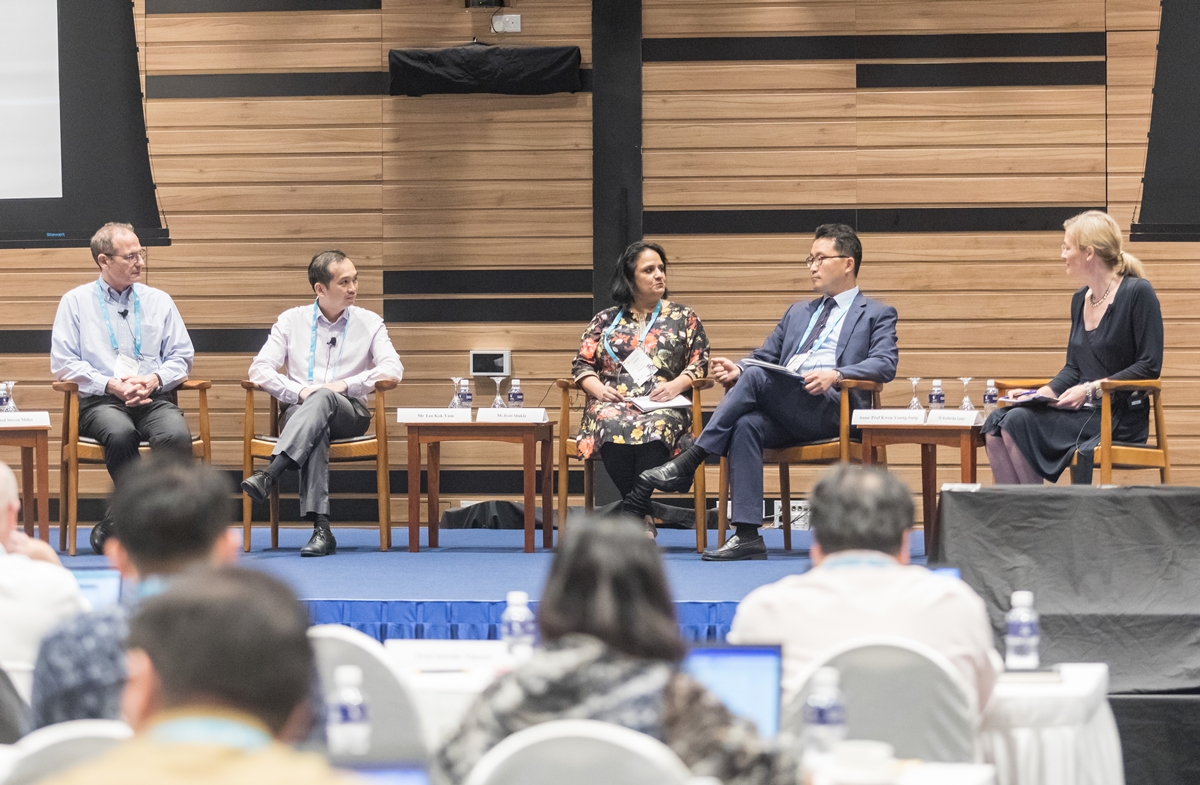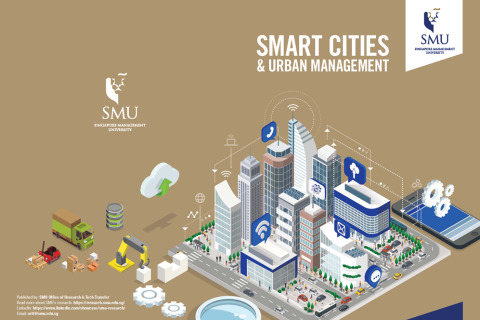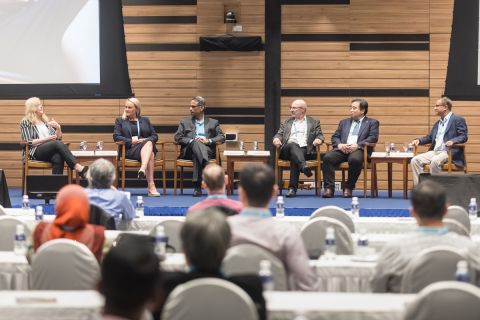
Above (left to right): Professor Steven Miller, Vice Provost (Research), SMU; Mr Tan Kok Yam, Deputy Secretary, Smart Nation and Digital Government Office; Ms Jyoti Shukla, Director, The World Bank; Associate Professor Kwon Young-Sang, Associate Professor of Urban Design, Department of Civil and Environmental Engineering, Seoul National University; Dr Katharina Lange, Executive Director, Executive Development, SMU
By Sim Shuzhen
SMU Office of Research & Tech Transfer – The swift pace of the tech industry may seem at odds with the cautious nature of government agencies. Yet, if smart cities are to go from blueprint to reality, the private and public sectors will have to navigate their differences and find ways of working together, agreed panellists at a discussion on ‘Engaging the Private Sector in University-Public Sector Smart City Partnerships’.
Moderated by Dr Katharina Lange, Executive Director of Executive Development at Singapore Management University (SMU), the discussion was held as part of the QS in Conversation seminar organised by SMU and QS Asia on the theme of ‘University-Public Sector Partnerships: Smart Cities’.
|
Above (left to right): Professor Steven Miller, Vice Provost (Research), SMU; Mr Tan Kok Yam, Deputy Secretary, Smart Nation and Digital Government Office; Ms Jyoti Shukla, Director, The World Bank |
Singapore, for its part, sees collaboration with the private sector as a key part of its smart city strategy. “We know we can’t do this on our own,” said Mr Tan Kok Yam, Deputy Secretary of Singapore’s Smart Nation and Digital Government Office. For example, while trying to streamline the administrative processes bereaved citizens have to handle upon the death of a family member, the government realised that many of these processes – closing bank and utility accounts, for example – involve the private sector. “We have to work with the private sector to make this as seamless as possible, so as not to create even more burden for people. That really requires a level of coordination and sharing of the mission,” said Mr Tan. |
Building capacity
Ms Jyoti Shukla, Director at the World Bank, Singapore, also named the private sector as an essential collaborator. “We believe nobody innovates better than the private sector. If we want our cities to be smart, the private sector is clearly an absolutely critical partner,” she said.
Part of the World Bank’s work involves helping governments and regulators in developing countries catch up with the private sector, Ms Shukla added. “Typically, cities and city governments are so far behind the private sector in this kind of [technological] innovation. This is where we want to make sure that our public sector partners are not just keeping pace with what is happening in private sector, but actually developing the platforms and the enabling environment in which such private sector innovation can occur,” she explained.
This type of capacity building remains important in developed countries – Singapore’s government, for instance, strives to build an ecosystem that encourages innovation, said Mr Tan. “It’s not the mission of the public sector to help any particular company save costs, improve revenue and so on – that’s the mission of the company itself. But as a way of facilitating the ecosystem, we are thinking of how we can make certain data exchanges possible and certain common digital tools accessible, so that the entire ecosystem can benefit. And sometimes doing that has great societal value in and of itself.”
|
As new and improved technologies emerge from the ecosystem, cities of the future may look radically different from those of today, which are typically arranged around a central hub, said Associate Professor Kwon Young-Sang of the department of civil and environmental engineering at Seoul National University, South Korea. “With advances in Internet of Things technology, big data systems, sustainable systems and future mobility systems, we can design cities with more democracy and equality in their structure… we can design them to be decentralised, with central areas open to the public so that citizens can use them freely.” |
Above (left to right): Ms Jyoti Shukla, Director, The World Bank; Associate Professor Kwon Young-Sang, Associate Professor of Urban Design, Department of Civil and Environmental Engineering, Seoul National University; Dr Katharina Lange, Executive Director, Executive Development, SMU |
Setting speed limits
But working with the private sector doesn’t mean that governments should beat to its drum all the time, agreed the panel. “We also know that with speed comes a certain risk,” said Dr Lange.
To minimise these risks, a standardised set of rules can be established around smart city collaborations, said Mr Tan. “It’s best to bake these rules into the digital system, but where that cannot be done, it boils down to a matter of trust, culture and practice that we have such exchanges,” he added.
Implementing this standardised infrastructure may require time and resources, but is a worthwhile investment, said Professor Steven Miller, Vice Provost (Research) at SMU. “Sometimes, if you make certain kinds of errors, the recovery effort is so vast that all of a sudden you regret your speed… some companies have a theme of ‘dream it, go out and test it’, but you do need processes and controls,” he said.
Before introducing a technology, the World Bank requires strong evidence that it will bring social, economic and policy benefits, stressed Ms Shukla. “The absorptive capacity of cities is much lower than the speed at which the private sector can innovate. Ultimately what we’re trying to do is build an ecosystem, and not have one part of the private sector [moving] so much faster than the rest of the ecosystem, because any system is only as strong as the weakest link in the chain,” she said.
At the same time, these precautions should not unnecessarily curtail the ambitions of the private sector, said Mr Tan, adding that strategies such as sandboxing can help innovative startups test their ideas safely. “Once those ideas work, then it’s about bringing everybody up to speed, and using and scaling that particular innovation. I think the diversity of speeds adds to the richness of the conversation, but at the same time you also want to make sure that vulnerable groups are not left behind.”
From silos to systems
When the private sector gets involved, policy makers also need to be on the lookout for unintended consequences, especially those that affect the fabric of society, said Professor Miller. For instance, young adults who sign up as drivers for ride hailing services may be putting off the skills training they need for a more sustainable career; at the same time, they also take away income from traditional taxi drivers in their 60s who are unlikely to make a career switch, he said.
“We can move fast on the innovation, but the private sector company is not going to worry about [problems like these]. So the public sector has to think of the macro-architecture and the long-term implications… my view is that just the market mechanisms without the central steering just aren’t going to get us there,” said Professor Miller.
Anticipating and dealing with unintended consequences requires systems thinking, a skill that governments – notorious for working in silos – need to work on developing, said the panel. In this, encouraging multidisciplinary interactions – between policy makers and IT departments, for example – will be critical. “It’s about making a very specific effort to provide individuals with different types of experiences that help them begin to appreciate the different elements of the same problem,” said Ms Shukla.
Back to Research@SMU February 2019 Issue
See More News
Want to see more of SMU Research?
Sign up for Research@SMU e-newslettter to know more about our research and research-related events!
If you would like to remove yourself from all our mailing list, please visit https://eservices.smu.edu.sg/internet/DNC/Default.aspx



